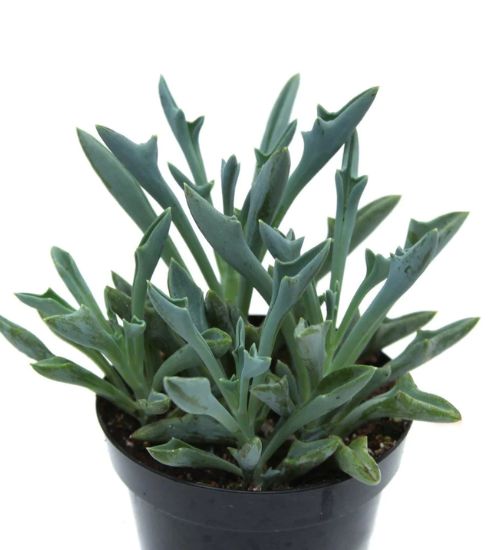Sun: full sun to partial shade
Water: Typical water needs for a succulent
Temperature: Zone 9b from 25° F to 30° F (-3.9° C to -1.1° C) to Zone 11b from 45° F to 50° F (7.2° C to 10° C)
Winter Survival: Not cold hardy
Propagation: cuttings, seeds
Flower: in the late summer and early fall
Flower Type: Yellow, white
Toxic: Toxic to humans and animals
Dormant: winter
Space Requirement: Indoors & Outdoors
Common Problems: Plants may rot if overwatered, pests
Where to buy Senecio kleiniiformis ‘Spearhead’?
Basc Care for Senecio kleiniiformis ‘Spearhead’
Watering
Regular watering period should be every 2 weeks
You can water your succulent more than often in extreme conditions but make sure that the soil is completely dry before watering your succulent again.
Fertilizing
Only feed this succulent during its active growing seasons which means winter. Use the right fertilizer applied in the right amounts. Applying half-strength balanced fertilizer every month or so is recommended for optimal results.
Do not fertilize during winter as the plant is dormant.
Sun & Location Requirements for "Spear Head, Spear Head Senecio, Reindeer Antlers"
Senecio kleiniiformis ‘Spearhead’ needs full sun to partial shade in order to thrive. While this variety needs plenty of bright light, it is important not to place it in direct sunlight for extended periods of time as this can cause damage or scorching to the leaves and stems. A shadier spot with indirect light could be just what "Spear Head, Spear Head Senecio, Reindeer Antlers" needs.
As per this succulent profile, it is only able to stay healthy when the environment temperature is above the range of zone 9b from 25° F to 30° F (-3.9° C to -1.1° C).
Senecio kleiniiformis ‘Spearhead’ is not cold hardy and does not survive in freezing conditions. However, there are certain strategies that can be used to help the plant thrive despite the chill of winter. Proper drainage and insulation are essential for succulent X during periods of extreme cold. Placing a layer of mulch or gravel on the soil around the plant can also help keep it warm.
Any succulents in the group will need a medium space to grow. You can place your pot at your table or window. Since this plant needs more space than mini succulents, you should consider do not plant them together with other succulents/plants.
Senecio kleiniiformis ‘Spearhead’ also benefits from some indirect light throughout the day as well, so make sure you give it enough space to soak up light without becoming too exposed to heat.
Propagation
One way to propagate Senecio kleiniiformis ‘Spearhead’ is by cutting
Propagating Senecio kleiniiformis ‘Spearhead’ from seeds is a great way to produce new plants without relying on cuttings or divisions. It's important to look for healthy, dark and plump seeds that are slightly sticky when touched. The soil should be pre-mixed with well-draining potting mix, before evenly sowing the seeds and pressing them into the surface. To ensure successful germination, gentle misting of the soil should be done and placed in indirect light.
Toxicity

All parts of Senecio kleiniiformis ‘Spearhead’ are considered to be poisonous, and should never be ingested. Even contact with the sap can cause serious skin irritations in humans and animals, so it’s important to wear gloves when handling them.
Pests and Diseases
Senecio kleiniiformis ‘Spearhead’ can be affected common pests and diseases like most of the other succulents such as aphids, mealybugs, and Red spider mites.
If you do spot any of pest signs, you can treat your succulent using below methods.
- Aphids: quarantine, clean infected plants, soapy water.
- Mealybugs: quarantine, clean infected plants, soapy water.
- Red spider mites: Quarantine, clean your infected plants, treatment with a systemic insecticidal/soapy water.
Besides that, to prevent serious health issues from happening, keep your succulent in a well-ventilated area and check it regularly for any signs of pests or health problems.


